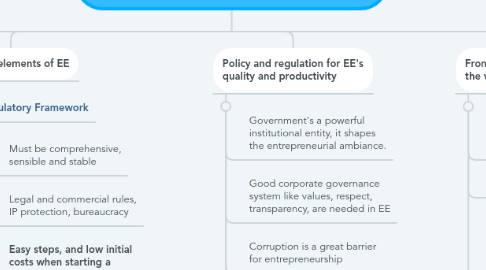
1. Introduction
1.1. Ecosystem: biological environment with biotic and abiotic components that interact.
1.2. Entrepreneurial Ecosystem: complex relationships of entrepreneurs, with the government, associations, consumers, investors, financial institutions, or culture, among others.
1.3. Good EEs values creativity, innovation, excellence, ideas, and partnerships
2. Natural & entrepreneurial ecosystems (NE & EE)
2.1. Productivity
2.1.1. In a NE it determines its size, and can be assessed through the synthesis rate of its components
2.1.2. In an EE it measures in which degree of efficiency the resources are used to create a positive impact
2.1.3. Entrepreneurial activity is higher when there are strong networks with other persons and institutions
2.2. Diversity
2.2.1. Higher diversity in an ecosystem means that it is healthy and in EE it means having a wide range of potential partners and niches
2.2.2. South Korea case: 'chaebols' or family-owned conglomerates supported by the government transformed the economy
2.2.2.1. Hyundai, Samsung and others supporting SMEs
2.3. Poor-quality species and parasites
2.3.1. Poor-quality members decrease productivity, and in EEs government's aids given to promote SMEs must have high standards.
2.3.1.1. Avoiding low-quality SMEs and supporting strong projects
2.3.1.1.1. Some failures: Canada's Labor Fund Program & Malaysia's BioValley, Dubai's Hub, or Australia's BITS
2.3.1.2. Parasites do not create value and are dragged, instead of helping it
2.4. Feedback systems
2.4.1. Feedback helps to maintain an equilibrium in the ecosystem and a continuous improvement
2.4.1.1. Entrepreneurial stories help to give a positive feedback to others, promoting entrepreneurship
3. Essential elements of EE
3.1. Regulatory Framework
3.1.1. Must be comprehensive, sensible and stable
3.1.2. Legal and commercial rules, IP protection, bureaucracy
3.1.3. Easy steps, and low initial costs when starting a business improve EE activity
3.2. Values, culture, & skills
3.2.1. Some cultures have prejudices against entrepreneurs (swiss, french, germans, arabs, latins)
3.2.2. Entrepreneurship must be worshiped like in USA
3.3. Access to finance, market, R&D and technology
3.3.1. A low trust in entrepreneurs or low capital available create bad EEs
3.4. Natural & geographic conditions
3.4.1. Transport routes, natural resources, weather conditions, biodiversity, etc..., help to create a better EE
3.4.2. Iceland's data Islandia
3.4.2.1. Using the country of origin features as a value proposition
3.4.3. Automobile Industry-Slovakia
3.4.3.1. The "mecca" for car production because of its location as a gateway for Balkan countries
3.4.4. Israel as a Clean Tech Hub
3.4.4.1. The sun that the country receives creates solar power, being attractive for new tech
3.4.5. Rare earth elements in China
3.4.5.1. China has a wide range of natural resources used in CT industry
4. Policy and regulation for EE's quality and productivity
4.1. Government's a powerful institutional entity, it shapes the entrepreneurial ambiance.
4.2. Good corporate governance system like values, respect, transparency, are needed in EE
4.3. Corruption is a great barrier for entrepreneurship
4.4. African Success stories
4.4.1. Rwanda
4.4.1.1. Stability after genocide, successful in attracting FDI: an image campaign, foreign offices for business, facilities for entrepreneurs
4.4.2. Ethiopia
4.4.2.1. Abolishing bureaucracy and costs resulted in an increase in new business.
5. From parts to the whole
5.1. Having a holistic view of the different components of a EE, in which all of them act in synergy
5.2. Israel & CT Industry
5.2.1. Sunny climate, supportive government policies, diversity, ethical systems, faith in entrepreneurs, FDI
5.3. In Scandinavia entrepreneurs are not admired people
5.4. Sweden is creating a program for promoting EE called TIMBRO
5.5. ForShe Case-Mumbai
5.5.1. A taxi company faced the big challenge of not having enough skilled female drivers
6. Concluding comments
6.1. A favorable EE
6.1.1. Entrepreneurial-friendly and supportive institutions
6.1.2. A culture focused on innovation
6.1.3. Supportive technologies
6.1.4. Good location, facilities and infrastructure
6.2. An ecosystem approach means a shift in focusing from parts to a whole and interconnected view
6.2.1. Must be assessed, monitored and well managed
7. Colombian entrepreneurial ecosystem
7.1. Colombia's case evidences how the government can change EE with enough effort
7.2. The country has to fight against low R&D spending and stigmas such as violence, corruption and drugs
7.3. Indicators for performance and impact
7.3.1. Good ranking in entrepreneurs-friendly
7.3.2. Economy based on natural resources and informality
7.4. Externalities: violence, insecurity and drugs
7.4.1. Homeless people from rural areas and migration due to violence
7.4.2. A challenge of changing a global negative image
7.4.3. Illegal entrepreneurship: drugs & guerillas
7.5. Regulatory framework
7.5.1. Uribe's effort against drugs, but a lack in civil law
7.5.2. CO ranked 3rd in Doing Business Ranking (costs, time, and bureaucracy)
7.5.3. Best country of the region for investor protection, support to SMEs
7.6. Signs of oligarchic capitalism
7.6.1. 4 business "grupos" share 12,5% of GDP, a higher disparity than Argentina or México
7.6.1.1. Family-owned "grupos" control politics in the country (and paras)
7.7. Banking, financial & capital markets
7.7.1. Low market size and capitalization
7.7.1.1. BVC-2001/LAIM-2011
7.7.1.2. Traditional business don't use banking & financing services
7.7.2. High remittances, and increasing FDI
7.8. Access to market, R&D, technology
7.8.1. Firms expand usually by M&A
7.8.1.1. FTA with USA increased mkt access
7.8.2. Colombia has potential
7.8.2.1. Medellín's Business culture
7.8.2.2. Clear, unaccented spanish
7.8.2.3. Entrepreneurial curiosity
7.8.3. Colombia's weaknesses
7.8.3.1. FDI isn't reflected in technology
7.8.3.2. Low spending on R&D
7.8.3.3. No corporate governance culture

